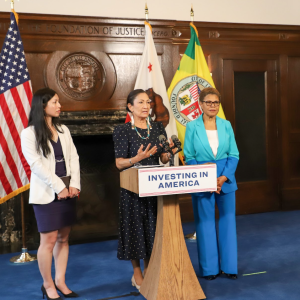 View Winners →
View Winners → State Superintendent Releases Guidance for Schools Reopening

State Superintendent of Public Instruction Tony Thurmond released a new manual from the California Department of Education (CDE) titled “Stronger Together: A Guidebook for the Safe Reopening of California’s Public Schools” on Monday. The how-to guide makes recommendations for schools to consider as they reopen but it is neither a “one-size-fits-all” document nor a mandate.
CDE recommends that all staff and students wear cloth face coverings or face shields while at school or on a bus, and maintain 6 feet of physical distance during school activities. Schools should purchase a sufficient number of no-touch thermal scan thermometers for screening, cleaning supplies to disinfect, PPE, hand sanitizers, soap, tissues, no-touch trash cans, and paper towels.
There should be a plan in place to close schools again for physical attendance of students, if it becomes necessary due to public health concerns. If a student or staff member tests positive for coronavirus, a school official, in conjunction with public health, may consider whether school closure is warranted. Campuses should also work towards minimizing access to campus, and limiting nonessential visitors, facility use permits, and volunteers.
In regards to hygiene, students and staff should be provided with opportunities to meet handwashing frequency guidance and with sufficient handwashing stations near classrooms to minimize classrooms and congregation in bathrooms. There should also be plenty of fragrance-free hand sanitizer available for students and staff.
CDE also provided schools with four instructional scheduling model options to consider:
- Two-Day Rotation Blended Learning Model: Students report to school on two designated days based on grade level for in-person instruction and on the other days, students are engaged in enrichment opportunities aligned with academic goals established by the school through various programs, either on site or with community partners, that are coordinated by school instructional staff. On Fridays, all students would be engaged in distance learning opportunities and teachers in collaborative planning and/or professional learning opportunities.
- A/B Week Blended Learning Model: Half of the student population attends in-person learning four full days per week while the other half is engaged in distance learning opportunities. The students would alternate each week. One day a week, all students would be engaged in distance learning while teachers would use the time for collaborative planning and professional learning.
- Looping Structure: For schools serving grade levels TK–8, there is an opportunity for students to stay with the same teacher in cohorts for multiple grade levels. For example, students would have the same teacher for first and second grade.
- Early/Late Staggered Schedules: Groups of grade levels would have staggered start and dismissal times, such as AM/PM rotations (for example, TK–2, 3–5, 6–8, 9–10, 11–12). The bell schedule would accommodate multiple recesses and lunch periods and multiple meal distribution points, along with time for students wash their hands before entering classrooms. Students could be in a homeroom with teachers rotating to decrease student congregation in hallways.
The state asks that districts keep distance learning as an option. According to Thurmond, in a survey, many parents asked that it remain an option. The superintendent underscored the need to continue bridging the digital divide among students.












































































































